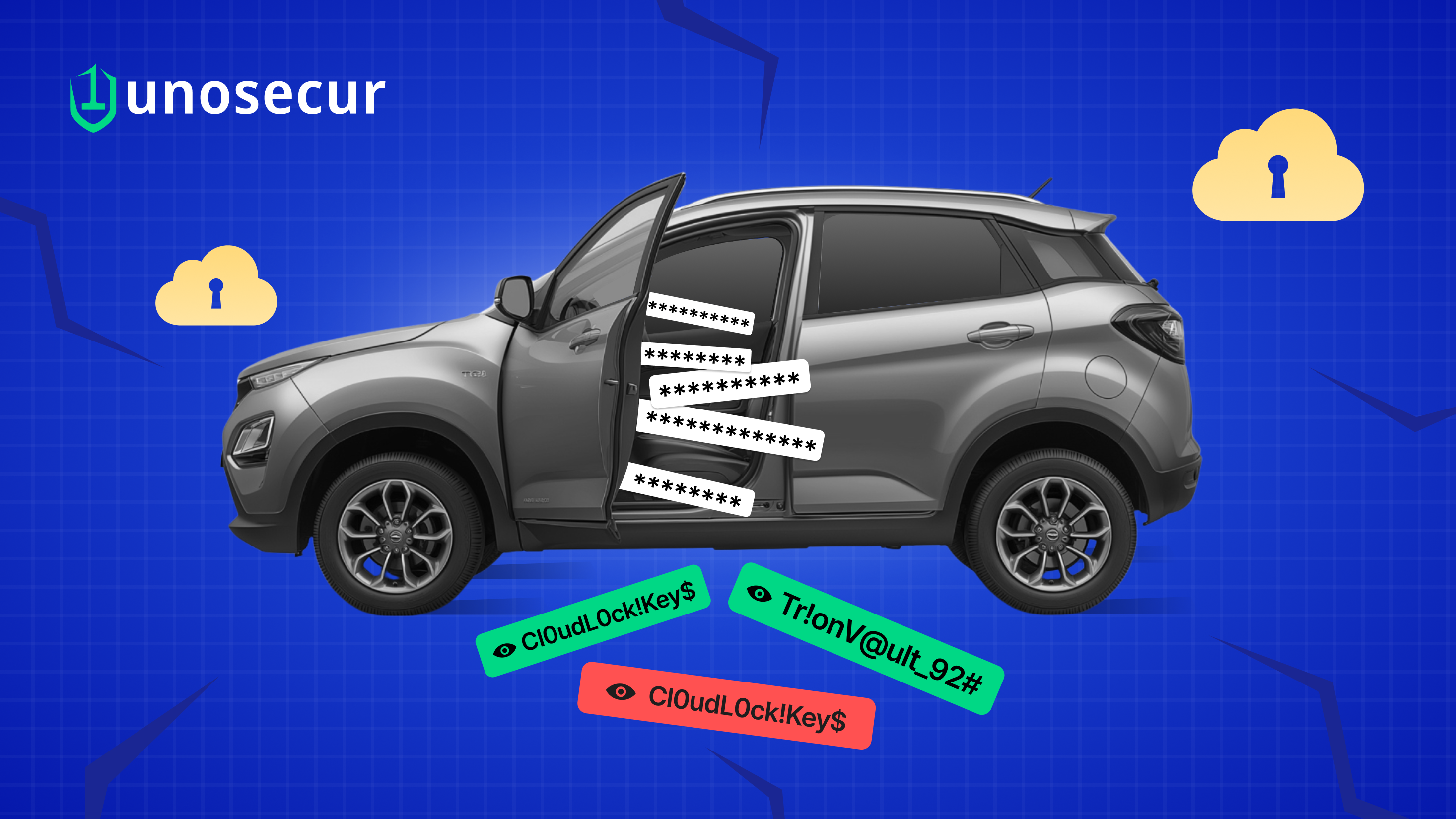Exposed Cloud Keys and Tokens: What Tata Motors’ Data Exposure Teaches About Secrets Management

TL;DR:
Two exposed AWS access keys and multiple hard-coded service tokens exposed tens of terabytes of data across Tata Motors’ cloud and analytics systems. The incident illustrates how static credentials and client-side secrets create invisible entry points for attackers. A unified identity monitoring approach could have detected exposed identities, risky permissions, and atypical credential usage far earlier.
What happened
In 2023, public web assets tied to Tata Motors contained embedded AWS access keys and third-party API tokens. These secrets granted access to hundreds of S3 buckets, a Tableau analytics instance, and a fleet-management integration amounting to 70 TB+ of sensitive data.
A marketplace website (E-Dukaan) had AWS keys in the frontend code. Another product (FleetEdge) used “client-side encrypted” keys in the browser, effectively no protection at all. In addition, a test-drive tracking portal exposed an Azuga API key, while the Tableau integration issued “trusted tokens” with only a username and site name, no password required, allowing account impersonation.
All credentials were reportedly rotated after coordinated disclosure via CERT IN, but the case underscores a broader challenge: how easily ordinary configuration mistakes become full-scale identity exposures in the cloud.
Why the issue matters: impact and risk
This incident highlights how credential compromise is now the leading cause of cloud incidents. Research shows that over one-third of cloud breaches begin with valid keys rather than malware. These intrusions bypass network controls because activity appears to originate from authorized users or applications.
For Tata Motors, two exposed key pairs provided global S3 access, while a weak Tableau token mechanism allowed large-scale dashboard impersonation. The problem wasn’t sophistication; it was unmanaged secrets and slow remediation.
Potential impact includes:
Broad exposure of internal and customer data (invoices with PANs, fleet telemetry, dashboards).
Write access to production systems through mis-scoped permissions and client-side keys.
Reputational damage and regulatory risk from leaked data tied to a major brand.
How the exposure happened
The exposure stemmed from multiple weak points across Tata Motors’ digital ecosystem. The public-facing E-Dukaan spare-parts portal included AWS access keys directly in its JavaScript source, allowing anyone viewing the page to reuse those credentials to enumerate or modify S3 data.
In the FleetEdge fleet-management product, the keys were “encrypted” on the client side, but the decryption logic was bundled within the same script,
making them easily retrievable by any user. These credentials alone exposed over 70 TB of fleet telemetry spanning decades.
Similarly, the Tableau integration’s front-end code contained a function that could issue valid admin-level tokens using only a username and site name,
with no password verification required, effectively granting privileged dashboard access.
To make matters worse, the test-drive tracking site leaked a valid Azuga API key in its JavaScript code, enabling programmatic access to vehicle and fleet data.
Each of these misconfigurations traces back to a common root cause: secrets being pushed to the client layer instead of being secured within a controlled identity fabric.
Signals to track
Identity-driven telemetry can provide early warning signs of similar exposures before they escalate into major incidents. Security teams should monitor for patterns such as the sudden appearance of AWS Access Key IDs in public repositories or web bundles, or unusual AWS API calls like GetCallerIdentity or ListBucket originating from unfamiliar IP addresses.
They should also watch for token-generation events that occur without multi-factor authentication or password verification, as well as credentials older than 90 days, or never previously used, suddenly becoming active. Another red flag is unexpected cross-account role assumptions or automated API calls from unknown origins.
These subtle signals often emerge days before the visible impact, offering a critical window for proactive containment.
Actionable Recommendations
To strengthen cloud credential hygiene and prevent similar exposures, organizations should adopt a disciplined approach to secrets management. All secrets and access keys must be removed from public assets; no credentials should ever appear in client-side code or repositories. Credentials should be rotated
regularly, ideally every 90 days, with automated expiry policies to minimize stale access. Applying the principle of least privilege is equally critical: replace
static keys with short-lived, role-based credentials to limit exposure. Multi-factor authentication and strict token scoping should be enforced for all
administrative and integration accounts. Continuous scanning integrated within CI/CD pipelines can help detect exposed credentials before deployment, while automated response workflows should immediately revoke and rotate compromised keys upon detection of risky activity. Finally, third-party integrations must be reviewed to ensure partner APIs follow the same standards for rotation, logging, and access scoping, closing external pathways that attackers often exploit.
Conclusion & key takeaways
The Tata Motors exposure underscores that credential hygiene is now as critical as perimeter defense. Even one leaked key can expose decades of operational data and connected systems. The key takeaway is to never embed credentials in client-facing code, enforce least privilege with temporary roles, and monitor identity usage continuously across all environments.
This is where Unosecur helps operationalize these principles, correlating identity signals across AWS, SaaS, and hybrid systems to detect exposed or misused credentials in real time. By linking discovery with automated remediation, Unosecur’s platform shortens the gap between exposure and containment from days to minutes.
Explore our other blogs
Don’t let hidden identities cost
you millions
Discover and lock down human & NHI risks at scale—powered by AI, zero breaches.


.png)
